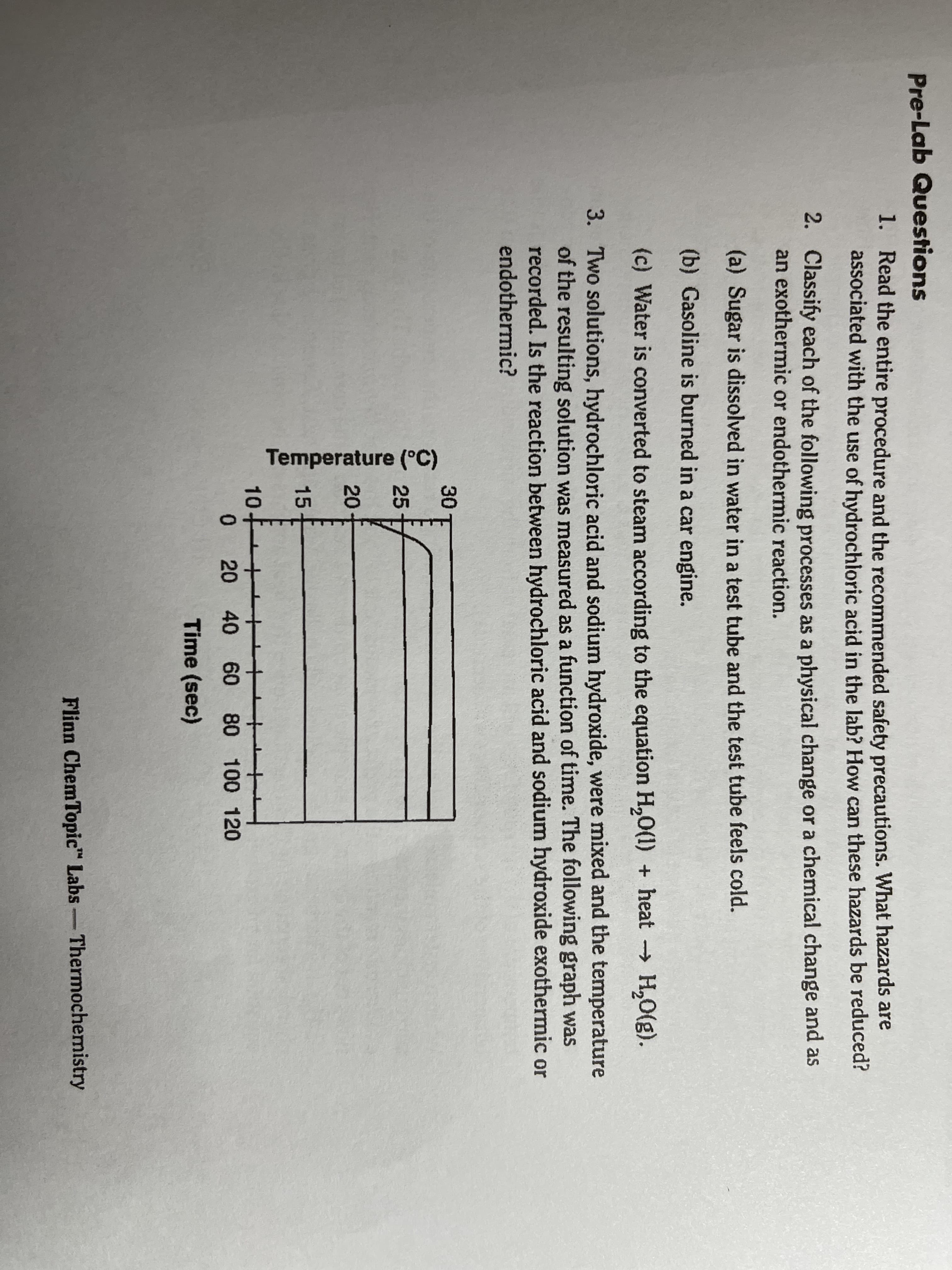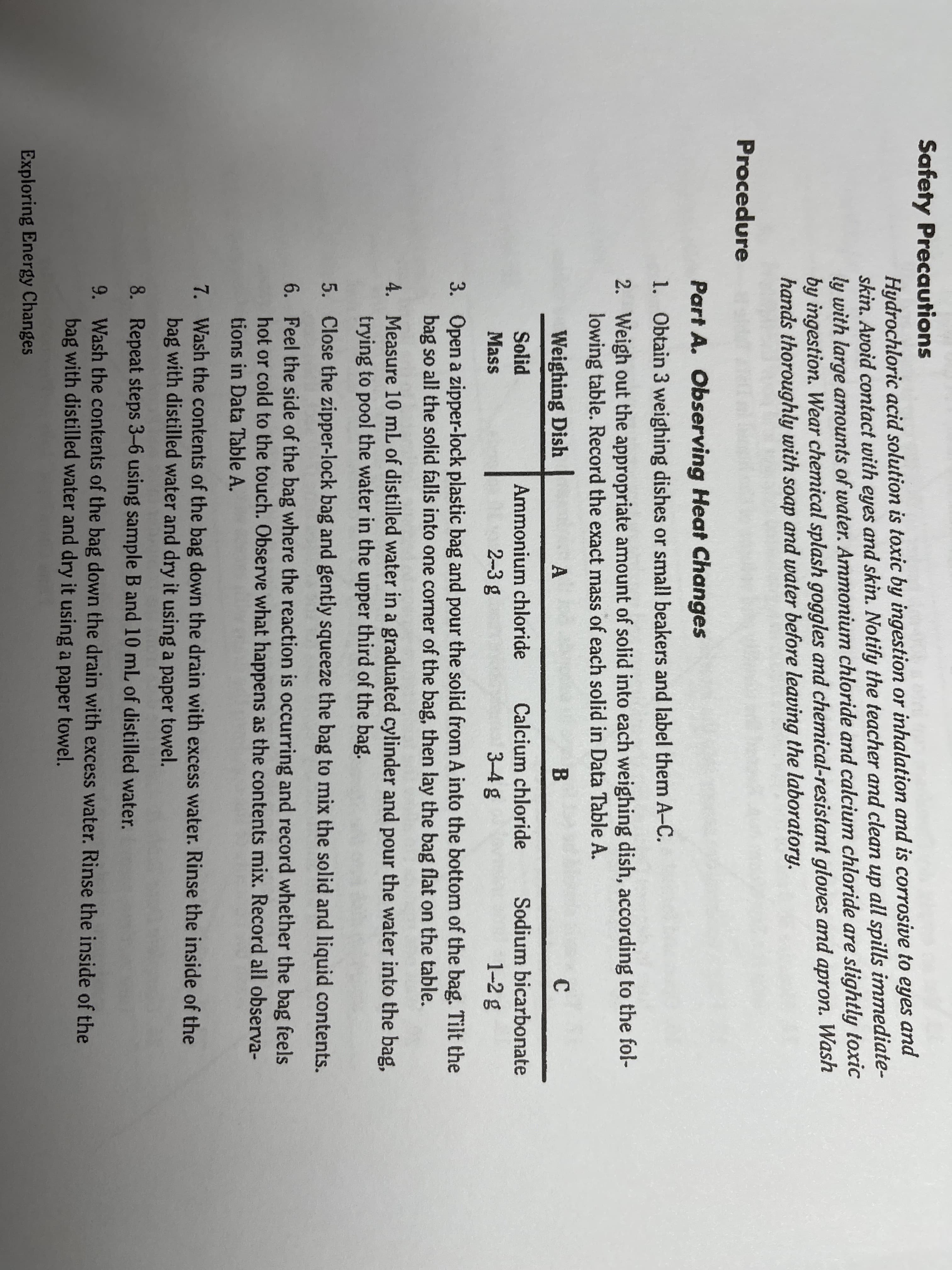Classify each of the following processes as a physical change or a chemical change and as an exothermic or endothermic reaction. (a) Sugar is dissolved in water in a test tube and the test tube feels cold. (b) Gasoline is burned in a car engine. (c) Water is converted to steam according to the equation H,0(1) + heat H,0).
Classify each of the following processes as a physical change or a chemical change and as an exothermic or endothermic reaction. (a) Sugar is dissolved in water in a test tube and the test tube feels cold. (b) Gasoline is burned in a car engine. (c) Water is converted to steam according to the equation H,0(1) + heat H,0).
ChapterU5: Fire: Energy , Thermodynamics, And Oxidation-reduction
Section: Chapter Questions
Problem 3STP
Related questions
Question
Answer the following pre lab questions. The safety precautions and procedures are in the photos that I sent.

Transcribed Image Text:Pre-Lab Questions
1. Read the entire procedure and the recommended safety precautions. What hazards are
associated with the use of hydrochloric acid in the lab? How can these hazards be reduced?
2. Classify each of the following processes as a physical change or a chemical change and as
an exothermic or endothermic reaction.
(a) Sugar is dissolved in water in a test tube and the test tube feels cold.
(b) Gasoline is burned in a car engine.
(c) Water is converted to steam according to the equation H,0(1) + heat H,0).
3. Two solutions, hydrochloric acid and sodium hydroxide, were mixed and the temperature
of the resulting solution was measured as a function of time. The following graph was
recorded. Is the reaction between hydrochloric acid and sodium hydroxide exothermic or
endothermic?
30
25
20
15
10
0 20 40 60 80 100 120
Time (sec)
Flinn ChemTopic" Labs-Thermochemistry
Temperature (°C)

Transcribed Image Text:Safety Precautions
Hydrochloric acid solution is toxic by ingestion or inhalation and is corrosive to eyes and
skin. Avoid contact with eyes and skin. Notify the teacher and clean up all spills immediate-
ly with large amounts of water. Ammonium chloride and calcium chloride are slightly toxic
by ingestion. Wear chemical splash goggles and chemical-resistant gloves and apron. Wash
hands thoroughly with soap and water before leaving the laboratory.
Procedure
Part A. Observing Heat Changes
1. Obtain 3 weighing dishes or small beakers and label them A-C.
2. Weigh out the appropriate amount of solid into each weighing dish, according to the fol-
lowing table. Record the exact mass of each solid in Data Table A.
Weighing Dish
A
C
Solid
Ammonium chloride
Calcium chloride
Sodium bicarbonate
Mass
2-3 g
3-4 g
1-2 g
3. Open a zipper-lock plastic bag and pour the solid from A into the bottom of the bag. Tilt the
bag so all the solid falls into one corner of the bag, then lay the bag flat on the table.
4. Measure 10 mL of distilled water in a graduated cylinder and pour the water into the bag,
trying to pool the water in the upper third of the bag.
5. Close the zipper-lock bag and gently squeeze the bag to mix the solid and liquid contents.
6. Feel the side of the bag where the reaction is occurring and record whether the bag feels
hot or cold to the touch. Observe what happens as the contents mix. Record all observa-
tions in Data Table A.
7. Wash the contents of the bag down the drain with excess water. Rinse the inside of the
bag with distilled water and dry it using a paper towel.
8. Repeat steps 3-6 using sample B and 10 mL of distilled water.
9. Wash the contents of the bag down the drain with excess water. Rinse the inside of the
bag with distilled water and dry it using a paper towel.
Exploring Energy Changes
Expert Solution
This question has been solved!
Explore an expertly crafted, step-by-step solution for a thorough understanding of key concepts.
This is a popular solution!
Trending now
This is a popular solution!
Step by step
Solved in 4 steps

Knowledge Booster
Learn more about
Need a deep-dive on the concept behind this application? Look no further. Learn more about this topic, chemistry and related others by exploring similar questions and additional content below.Recommended textbooks for you


Introductory Chemistry: An Active Learning Approa…
Chemistry
ISBN:
9781305079250
Author:
Mark S. Cracolice, Ed Peters
Publisher:
Cengage Learning

Chemistry for Today: General, Organic, and Bioche…
Chemistry
ISBN:
9781305960060
Author:
Spencer L. Seager, Michael R. Slabaugh, Maren S. Hansen
Publisher:
Cengage Learning


Introductory Chemistry: An Active Learning Approa…
Chemistry
ISBN:
9781305079250
Author:
Mark S. Cracolice, Ed Peters
Publisher:
Cengage Learning

Chemistry for Today: General, Organic, and Bioche…
Chemistry
ISBN:
9781305960060
Author:
Spencer L. Seager, Michael R. Slabaugh, Maren S. Hansen
Publisher:
Cengage Learning


Introductory Chemistry: A Foundation
Chemistry
ISBN:
9781337399425
Author:
Steven S. Zumdahl, Donald J. DeCoste
Publisher:
Cengage Learning